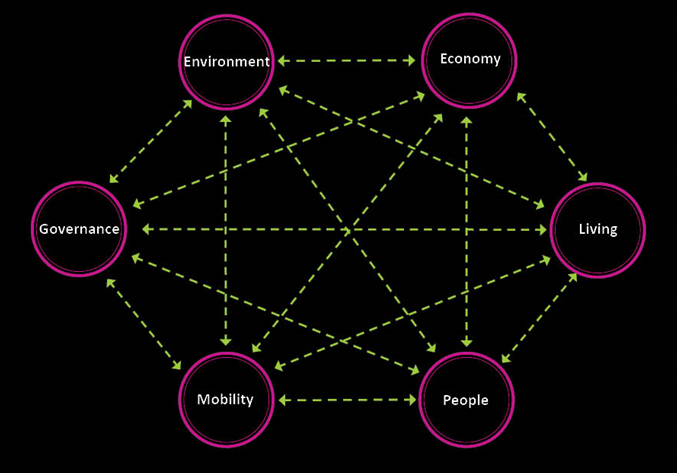| Overview | What is a Smart city | Characteriscts Smart | Emerging Topics | Actors | Networks | Educations | Pubblications |
_
_
Numerous international studies, including the first one carried out by the Vienna University of Technology European Smart city project project and the study of the European Parliament Mapping Smart Cities in the EU, define the Smart city as a city able to operate, effectively, through policies and actions relating to six different smart features: environment, economy, living, people, mobility, governance. The effectiveness with respect to each of them is measured thanks to the performance and quantitative indicators. A city is defined more Smart the more it is able to implement projects and innovative initiatives that integrate, in a complex way, different characteristics.

_
![]()

By smart environment we include smart energy including renewables, ICTenabled energy grids, metering, pollution control and monitoring, renovation of buildings and amenities, green buildings, green urban planning, as well as resource use efficiency, re-use and resource substitution which serves the above goals. Urban services such as street lighting, waste management, drainage systems, and water resource systems that are monitored to evaluate the system, reduce pollution and improve water quality are also good examples.

By Smart Economy we mean e-business and e-commerce, increased productivity, ICT-enabled and advanced manufacturing and delivery of services, ICT-enabled innovation, as well as new products, new services and business models. It also establishes smart clusters and eco-systems (e.g. digital business and entrepreneurship). Smart Economy also entails local and global inter-connectedness and international embeddedness with physical and virtual flows of goods, services and knowledge
_

By Smart Governance we mean joined up within-city and across-city governance, including services and interactions which link and, where relevant, integrate public, private, civil and European Community organisations so the city can function efficiently and effectively as one organism. The main enabling tool to achieve this is ICT (infrastructures, hardware and software), enabled by smart processes and interoperability and fuelled by data. International, national and hinterland links are also important (beyond the city), given that a Smart City could be described as quintessentially a globally networked hub. This entails public, private and civil partnerships and collaboration with different stakeholders working together in pursuing smart objectives at city level.

By Smart Economy we mean e-business and e-commerce, increased productivity, ICT-enabled and advanced manufacturing and delivery of services, ICT-enabled innovation, as well as new products, new services and business models. It also establishes smart clusters and eco-systems (e.g. digital business and entrepreneurship). Smart Economy also entails local and global inter-connectedness and international embeddedness with physical and virtual flows of goods, services and knowledge.
_
By Smart Living we mean ICT-enabled life styles, behaviour and consumption. Smart Living is also healthy and safe living in a culturally vibrant city with diverse cultural facilities, and incorporates good quality housing and accommodation. Smart Living is also linked to high levels of social cohesion and social capital.

By Smart People we mean e-skills, working in ICT-enabled working, having access to education and training, human resources and capacity management, within an inclusive society that improves creativity and fosters innovation. As a characteristic, it can also enable people and communities to themselves input, use, manipulate and personalise data, for example through appropriate data analytic tools and dashboards, to make decisions and create products and services.
![]()
Definitions extracted from the study of the European Parliament «Mapping Smart Cities in the EU» 2014





